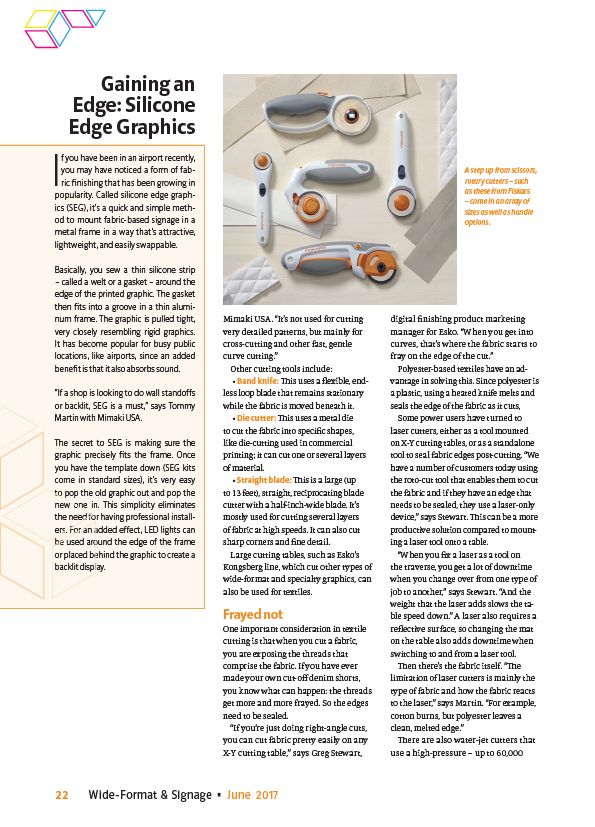
Gaining an
Edge: Silicone
Edge Graphics
If you have been in an airport recently,
you may have noticed a form of fabric
fi nishing that has been growing in
popularity. Called silicone edge graphics
(SEG), it’s a quick and simple method
to mount fabric-based signage in a
metal frame in a way that’s attractive,
lightweight, and easily swappable.
Basically, you sew a thin silicone strip
– called a welt or a gasket – around the
edge of the printed graphic. The gasket
then fi ts into a groove in a thin aluminum
frame. The graphic is pulled tight,
very closely resembling rigid graphics.
It has become popular for busy public
locations, like airports, since an added
benefi t is that it also absorbs sound.
“If a shop is looking to do wall standoffs
or backlit, SEG is a must,” says Tommy
Martin with Mimaki USA.
The secret to SEG is making sure the
graphic precisely fi ts the frame. Once
you have the template down (SEG kits
come in standard sizes), it’s very easy
to
pop the old graphic out and pop the
new w one
one in. This simplicity eliminates
the need for having professional installers.
ed fo
o
a
aro
e
l
For an added effect, LED lights can
ers.Fo
be used around the edge of the frame
or placed behind the graphic to create a
backlit display.
Mimaki USA. “It’s not used for cutting
very detailed patterns, but mainly for
cross-cutting and other fast, gentle
curve cutting.”
Other cutting tools include:
• Band knife: Th is uses a fl exible, endless
loop blade that remains stationary
while the fabric is moved beneath it.
• Die cutter: Th is uses a metal die
to cut the fabric into specifi c shapes,
like die-cutting used in commercial
printing; it can cut one or several layers
of material.
• Straight blade: Th is is a large (up
to 13 feet), straight, reciprocating blade
cutter with a half-inch-wide blade. It’s
mostly used for cutting several layers
of fabric at high speeds. It can also cut
sharp corners and fi ne detail.
Large cutting tables, such as Esko’s
Kongsberg line, which cut other types of
wide-format and specialty graphics, can
also be used for textiles.
Frayed not
One important consideration in textile
cutting is that when you cut a fabric,
you are exposing the threads that
comprise the fabric. If you have ever
made your own cut-off denim shorts,
you know what can happen: the threads
get more and more frayed. So the edges
need to be sealed.
“If you’re just doing right-angle cuts,
you can cut fabric pretty easily on any
X-Y cutting table,” says Greg Stewart,
22 Wide-Format & Signage June 2017
A step up from scissors,
rotary cutters – such
as these from Fiskars
– come in an array of
sizes as well as handle
options.
digital fi nishing product marketing
manager for Esko. “When you get into
curves, that’s where the fabric starts to
fray on the edge of the cut.”
Polyester-based textiles have an advantage
in solving this. Since polyester is
a plastic, using a heated knife melts and
seals the edge of the fabric as it cuts,
Some power users have turned to
laser cutters, either as a tool mounted
on X-Y cutting tables, or as a standalone
tool to seal fabric edges post-cutting. “We
have a number of customers today using
the roto-cut tool that enables them to cut
the fabric and if they have an edge that
needs to be sealed, they use a laser-only
device,” says Stewart. Th is can be a more
productive solution compared to mounting
a laser tool onto a table.
“When you fi x a laser as a tool on
the traverse, you get a lot of downtime
when you change over from one type of
job to another,” says Stewart. “And the
weight that the laser adds slows the table
speed down.” A laser also requires a
refl ective surface, so changing the mat
on the table also adds downtime when
switching to and from a laser tool.
Th en there’s the fabric itself. “Th e
limitation of laser cutters is mainly the
type of fabric and how the fabric reacts
to the laser,” says Martin. “For example,
cotton burns, but polyester leaves a
clean, melted edge.”
Th ere are also water-jet cutters that
use a high-pressure – up to 60,000